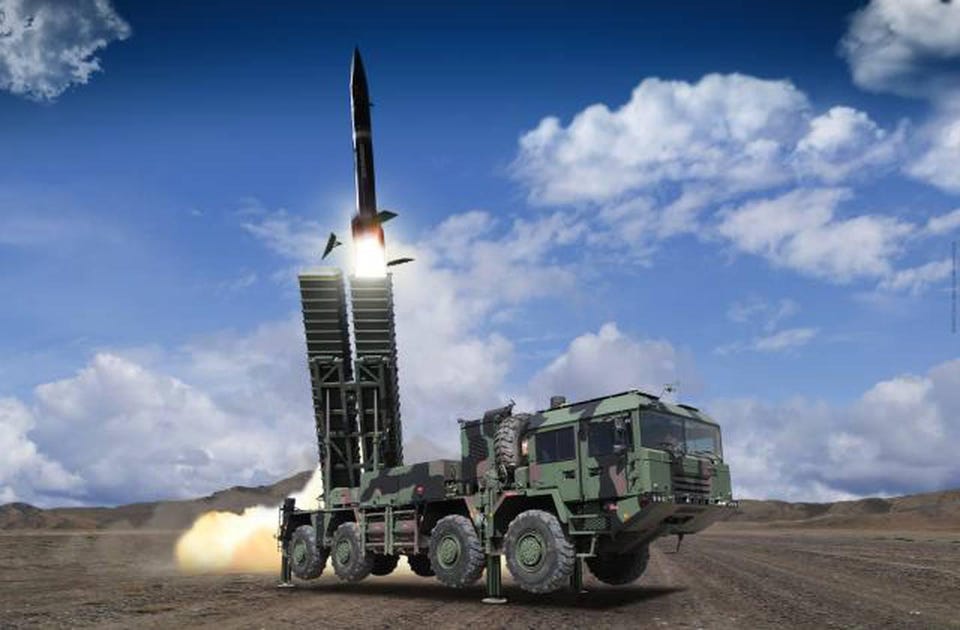Aerospace & Defense Tayfun Test-Firing Puts Spotlight On Turkey’s Ballistic Missile Program Paul Iddon Contributor Opinions expressed by Forbes Contributors are their own. I write mostly about Middle East affairs, politics and history. Following New! Follow this author to stay notified about their latest stories.
Got it! Oct 20, 2022, 09:33am EDT | New! Click on the conversation bubble to join the conversation Got it! Share to Facebook Share to Twitter Share to Linkedin Turkey’s test-firing of a new short-range ballistic missile (SRBM) over the Black Sea on Oct. 18, 2022, is a reminder that Ankara possesses a significant arsenal of such missiles. It also indicates that it aims to expand and enhance that arsenal.
According to preliminary reports, the Tayfun (Turkish for “Typhoon”) SRBM developed by Turkey’s Roketsan was test-fired from a mobile launcher in the city of Rize on the Black Sea coast. The missile traveled a distance of 350 miles before crashing off the coast of the Black Sea port of Sinop. That distance is twice the range of the current ballistic missiles in the Turkish arsenal, or at least the known ones.
Roketsan unveiled the Bora-1 (Turkish for “Storm-1”) ballistic missile, which has a much shorter range of 170 miles, in 2017. According to Rocketsan, the Bora-1 has a 470-kilogram warhead and is accurate to within 50 meters. Turkey reportedly fired one of these missiles at a Kurdistan Workers’ Party (PKK) target in Iraqi Kurdistan in May 2019.
Official animation depicting a Turkish Bora-1 ballistic missile being fired from its mobile . . .
[+] launcher. Roketsan The range and the payload of the Bora-1 comply with the Missile Technology Control Regime (MTCR), of which Turkey is a member. The MTCR is a multilateral export control regime that seeks to reduce missile proliferation by compelling its signatories not to export drones or missiles with payloads exceeding 500 kg and ranges over 190 miles.
The Tayfun missile is the first known missile Turkey has tested that exceeds this range. Its payload, on the other hand, is not presently known. Well before the Oct.
18 Tayfun test, there were some suspicions that Turkey intended to develop a missile with a greater range and payload than recommended by the MTCR. In April 2018, Turkey’s defense minister said the upcoming Bora-2 will have “more advanced missile technology than the Bora-1 and a longer range” and more locally produced components (the guidance systems of the Bora-1 are American-made). However, whether the Bora-2 would stay within the MTCR’s recommended range limit was questionable.
After all, to do so, the “longer range” would be less than an extra 20 miles, and the payload a mere additional 30 kg. MORE FOR YOU Hiring Refugees: How One Big Factory Did It Stripe Takes Steps To Prune Workforce 6 Time Management Tips To Avoid Having Too Much Work In Progress According to Turkey’s state-run press , the “structure of the Tayfun’s launcher is very similar to that of the Bora”. It’s possible, perhaps even likely, that Tayfun is the same project to develop the Bora-2 since Rocketsan is overseeing it.
Of course, Turkey may have no intention of exporting the Tayfun. It may just want a longer-range missile to enhance its deterrence. That wouldn’t be a stretch given that, in 2011, the Turkish government said it had plans to build a missile with a 2,500 km (1,550 miles) range, although it notably did not specify whether it would be a ballistic or cruise missile.
“Paying tribute to geostrategic, technological, cost, and foreign policy considerations, the optimum range bracket for Turkey’s ballistic missiles appears to be around 800 kilometers (500 miles),” noted a 2017 academic paper . “Recent calls for ballistic missiles of much longer ranges (e. g.
2,500 km) do not correspond to Turkey’s geostrategic and security circumstances. ” It’s unclear if the timing of the Oct. 18 test was meant to send a message.
Unlike neighboring Iran, which has the largest ballistic missile program in the region and seemingly seizes every opportunity to flaunt and parade its missiles before the public, Turkey has been quite discreet about possessing such weapons. The program’s origins go back to the 1990s when Turkey reached a deal with China, allowing it to produce Chinese B-611 missiles under license. That led to the creation of the J-600T Yildirim tactical ballistic missile using Chinese technology.
Those weren’t revealed to the public until 2007. The two known variants of that missile – with ranges of 90 and 180 miles, respectively – neatly fit within the MTCR’s recommended limits. Tehran, by contrast, is not a signatory of the MTCR and just last February boasted that its new Kheibar Shekan (Persian for “Kheibar buster”) ballistic missile has a range of 1,200 miles.
In September, Iran fired several ballistic missiles into Iraqi Kurdistan, targeting Iranian Kurdish opposition groups. Turkey may have chosen now to test the Tayfun to remind the broader region that it is also a missile power with a significant reach. The Oct.
18 test also coincided with tensions with Greece, which renewed fears of war between the two NATO members. Turkish social media users have shared maps showing how all of Greece falls within the range of these Turkish missiles. Furthermore, Turkish officials are irked by the extensive expansion and modernization of the Hellenic armed forces, which, as previously outlined here , could result in Greece fielding a significantly more advanced air force than Turkey.
Turkey might also have intended to demonstrate the growing reach of its firepower to Russia, signaling its disapproval of Turkey crossing certain red lines in the Black Sea or other areas where Ankara and Moscow have diverging interests. Or the timing of the test was merely coincidental and had more to do with the pace of the Tayfun’s development than these events. Follow me on Twitter .
Paul Iddon Editorial Standards Print Reprints & Permissions.
From: forbes
URL: https://www.forbes.com/sites/pauliddon/2022/10/20/tayfun-test-firing-puts-spotlight-on-turkeys-ballistic-missile-program/
